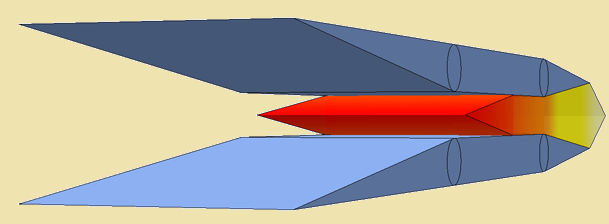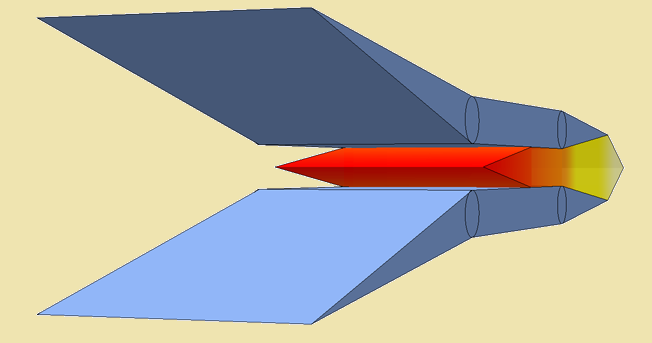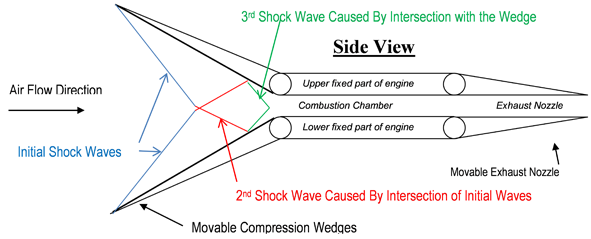Practical Ramjet and Scramjet Designs Radically Reduce Spaceflight Cost
Ramjets are far more fuel efficient than rockets and can travel much faster��than turbojets. They contain no rotating parts and are mechanically simple. The compressor of a turbojet is replaced by the ramming effect of the engine’s forward motion into the onrushing air���thus the term ramjet engine.
Since a ramjet can only operate efficiently at one optimal speed, to operate efficiently at a wide range of speeds would require 100 different ramjets. Thus, our task is to dynamically change our single ramjet into 100 different ramjets as we move along our flight envelope. Our single ramjet must change shape to form each of the 100 different ramjets we need. What we seek is a variable geometry ramjet than can transition itself and reconfigure itself into the 100 different ramjet shapes. What is also needed is the ability for this single ramjet engine to further warp itself into the form a hypersonic scramjet as we increase speed and altitude.
The key to low-cost next generation space travel is an inexpensive air-breathing propulsion system to propel the spacecraft into near orbital conditions. To accomplish this, a wide flight envelope ramjet / scramjet must be further studied and designed.
To build a low cost spacecraft we need the simplest mechanical shapes and actuators to form the variable geometry ramjet. What could be mechanically simpler than a door? Therefore, our variable geometry moving surfaces will resemble doors, i.e. a flat surface moving about a pivot point like a door swinging on a hinge.
In order to fly at the extremely high speeds I am proposing, we must fly at very high altitudes (150,000 feet) where air friction is extremely low. Supporting combustion in such low density altitudes can be problematic. Thus, we must collect large amounts of air and compress it significantly to support combustion. This can be accomplished with a very large air-intake aperture as compared to the combustion chamber’s dimensions. In other words, we may need a very large opening during the highest part of the flight to gulp more air.
Below are examples of such a ramjet engine configured for different air-intake openings for different segments of its flight:



It’s not enough to collect large amounts of air. It is also important to compress this air enough to support combustion. The supersonic shock waves that will form between the air-intakes will compress the onrushing air.
Let me greatly simplify supersonic air compression by saying a supersonic shock wave is created when air impacts a wedge shape. The air before the shock wave is at a lower density than the air after the shock wave. If you look at a wedge shape inside a supersonic wind tunnel you can actually see the shock waves it produces. Think of it as sound that is so intense you can see it. It appears to look like a sheet of glass separating the two areas of air density.
Air passing from one side of the shock wave to the other is compressed. It is reasonable to think of the supersonic shock waves as performing a similar function as the compressor blades inside a turbojet engine.
Similarly, the more shock waves you have, the greater the compression can become, just like multiple stages of compressor blades further compress the air in a turbojet.
The initial shock wave from the top wedge may intersect with the initial shock wave from bottom wedge with the intersection creating another set of shock waves for the onrushing air to pass through. These second shock waves may then intersect with the wedge surfaces creating a third set of shock waves. The illustration below graphically depicts this interaction.
 The above explanation is an over simplification of the actual number of shock waves that may be created between the two wedges. As a general rule the further the wedges are spread apart, the more shock waves will be created. However, this rule is highly dependent on the altitude and speed of the spacecraft.
The above explanation is an over simplification of the actual number of shock waves that may be created between the two wedges. As a general rule the further the wedges are spread apart, the more shock waves will be created. However, this rule is highly dependent on the altitude and speed of the spacecraft.
Since ramjet technology was mostly abandoned in the 1950s, we have greatly increased our knowledge of hypersonic airflow and computer modeling techniques. We can now simulate and calculate what optimal air-intake angles the wedges will require for maximum efficiency. Further, spacecraft materials have significantly advanced so that these high speed-ramjets can withstand the high-temperatures of such high-speed hypersonic flight. What was impossible complex technology in the 1950s is trivial today.
As compared to rockets, ramjets and scramjets are a practical and dramatically lower cost methodology for the booster phase of a spacecraft.
In the book, “What If We Made Space Travel Practical?” several solutions regarding supersonic and hypersonic ramjets and scramjets are presented.
